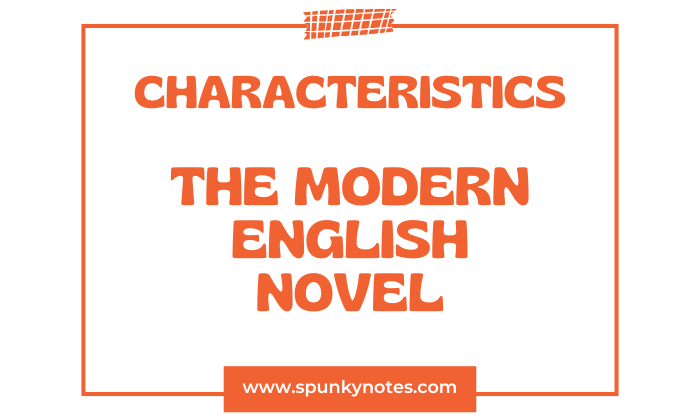
Q. What are the major characteristics of the modern English novel?
Introduction
The modern English novel has evolved significantly, reflecting diverse aspects of human life and societal changes. These novels often focus on realism, presenting life’s scenarios as they are.
Authors experiment with narrative structures, breaking away from traditional storytelling to include techniques like stream of consciousness. Modern novels also dive deeply into character development.
It emphasizes emotional and psychological depth. Themes of alienation and societal critique are prevalent, addressing individuals’ social disconnect and struggles against oppressive structures.
Characteristics of the Modern Novel
- Realism
- Experimental Narrative Structures
- Character Development
- Alienation and Fragmentation
- Socio-Political Critique
- Symbolism
- Psychological Depth
- Diverse Perspectives and Voices
1- Realism
Authors use realism in modern English novels to reflect the actual experiences and complexities of everyday life. This approach allows readers to see themselves in the characters and the situations they face, which are often a direct mirror of real life.
Hard Times
One notable example is Charles Dickens’ “Hard Times,” which portrays the struggles of the working class in an industrializing England. Dickens uses vivid descriptions and develops characters that endure economic and emotional hardships, making the story relatable and impactful for readers.
North and South
Similarly, Elizabeth Gaskell’s “North and South” examines the contrasts between the industrial North of England and the wealthier South while focusing on issues like class conflict, labour rights, and romantic entanglement within these settings.
These novels provide a window into the lives of diverse characters, from factory workers to middle-class families. Realism makes the narrative more meaningful and educational by focusing on detailed character development and realistic settings.
2- Experimental Narrative Structures
Modern English novels often feature experimental narrative structures that challenge traditional storytelling methods.
These structures can include non-linear timelines, multiple viewpoints, and other innovative techniques that offer fresh ways of understanding the story and its characters.
The Waves
Virginia Woolf’s “The Waves” is a prime example of experimental narrative structure. The novel is composed of soliloquies spoken by six characters.
Woolf uses this format to delve deeply into each character’s thoughts and emotions, providing a multi-dimensional view of their lives and relationships without a traditional narrative flow.
The Sound and the Fury
William Faulkner’s “The Sound and the Fury” employs a complex narrative structure with four distinct sections, each from a different character’s perspective and in different styles.
The first section is particularly challenging, as it is narrated through the disjointed thoughts of Benjy, a man with intellectual disabilities. This approach allows readers to create the story from diverse perspectives and styles.
These novels illustrate how experimental narrative structures can enrich a story. By breaking away from conventional storytelling, authors like Woolf and Faulkner create engaging works encouraging readers to interact with the text in more involved and personal ways.
3- Character Development
Modern English novels often emphasize character development, showing how characters evolve from their initial circumstances through various life experiences.
This evolution is depicted through changes in their behaviours, beliefs, and relationships, which provide a deeper understanding of their personalities and the human condition.
A Portrait of the Artist as a Young Man
In “A Portrait of the Artist as a Young Man,” James Joyce explores Stephen Dedalus’s growth from a young boy to a man who rejects the conventional paths laid out for him.
Initially, Stephen is influenced by the religious and cultural expectations of his Irish family and community. As he matures, he becomes increasingly aware of his desire to forge an artist’s path, eventually rejecting his earlier conformities to embrace a life dedicated to art.
This transformation highlights his personal awakening and artistic self-realization.
Mrs. Dalloway
Virginia Woolf’s “Mrs. Dalloway” focuses on Clarissa Dalloway, a high-society woman preparing for a party. Throughout the novel, we see Clarissa reflecting on her past decisions, particularly her choice of husband, which brings to light her doubts and the constraints of her societal role.
The novel moves through her preparations and flashbacks to her youth, showing her evolution from a vibrant young woman to a reflective, somewhat regretful adult, grappling with her identity and life choices.
Heart of Darkness
In “Heart of Darkness,” Joseph Conrad details the journey of Charles Marlow, a steamboat captain navigating the Congo River.
As Marlow ventures deeper into the African continent, he confronts not only the darkness of the colonial exploitation around him but also the darkness within himself and humanity.
This journey profoundly changes his view of the world and himself, illustrating a stark transformation from an adventurous explorer to a disillusioned observer of human nature.
4- Alienation and Fragmentation
Modern English novels frequently address themes of alienation and fragmentation. It reflects the characters’ experiences of isolation from society and the disjointed nature of modern life.
These themes highlight the struggles of individuals trying to find their place in a world that often seems indifferent or hostile.
The Metamorphosis
Franz Kafka’s “The Metamorphosis” presents Gregor Samsa, who awakens to be transformed into a monstrous insect.
This bizarre transformation exaggerates his sense of disconnection from his family and society. Kafka uses this extreme scenario to explore deeper feelings of alienation and existential dread.
Mrs. Dalloway
Virginia Woolf’s Mrs Dalloway features characters struggling with internal and external isolation. The protagonist, Clarissa Dalloway, spends a day reflecting on her past choices and her place in society.
The novel’s stream-of-consciousness style captures the fragmented thoughts of Clarissa and others, highlighting their personal alienation amidst post-war societal changes.
Heart of Darkness
Joseph Conrad’s “Heart of Darkness” explores Charles Marlow’s alienation as he travels into the African interior. The journey is not just geographical but also a descent into the darker parts of the human psyche.
Marlow feels increasingly isolated as he confronts the moral and existential void at the heart of colonial exploitation, symbolizing the fragmentation of his worldview.
5- Socio-Political Critique
Modern English novels often analyze societal issues and the impacts of political decisions on individuals.
1984
George Orwell’s “1984” critiques totalitarian regimes. It explores government surveillance and truth manipulation, highlighting the dangers of absolute political power.
The Handmaid’s Tale
Margaret Atwood’s “The Handmaid’s Tale” addresses gender politics and women’s rights in a dystopian future. It exposes extreme control over women, linking to both current and historical socio-political issues.
These novels use stories to examine and question societal norms and political structures. They encourage readers to think about the power dynamics in their own lives.
6- Symbolism
Symbolism is a powerful literary tool used in modern English novels to convey deeper meanings through objects, characters, or events. This technique enriches narratives by adding layers of meaning that extend beyond the literal.
The Great Gatsby
In “The Great Gatsby,” F. Scott Fitzgerald uses the green light at the end of Daisy’s dock to symbolize Gatsby’s longing and the American Dream’s elusive nature.
It represents his unattainable desires and the broader theme of pursuing happiness through material wealth.
The Scarlet Letter
Nathaniel Hawthorne’s “The Scarlet Letter” employs the scarlet letter “A” worn by Hester Prynne as a complex symbol. Initially, it symbolizes adultery and Hester’s public shaming, but it evolves to represent her strength, resilience, and the community’s hypocrisy.
7- Psychological Depth
Psychological depth in novels explores characters’ complex mental and emotional layers, enriching narratives with a profound understanding of human nature.
Atonement
“Atonement” by Ian McEwan examines the effects of a false accusation through Briony Tallis’s guilt and quest for redemption. The novel delves deeply into Briony’s psyche, exploring how her actions reshape her life and the lives of others.
Middlemarch
George Eliot’s “Middlemarch” intricately explores the inner lives of multiple characters, particularly Dorothea Brooke and Tertius Lydgate.
Their aspirations and disillusionments are portrayed with depth, showing how their personal journeys are influenced by their social environment and personal choices.
8- Diverse Perspectives and Voices
Modern English novels often include various cultural, social, and personal viewpoints. This approach makes storytelling richer and gives readers insights into different ways of life.
White Teeth
Zadie Smith’s “White Teeth” vividly portrays multicultural London through the lives of two diverse families. The novel examines identity, heritage, and how past and present mix in a bustling city.
Americanah
“Americanah” by Chimamanda Ngozi Adichie tells the story of Ifemelu, a Nigerian woman living in the United States and later in Nigeria. The book discusses race, immigration, and identity through her experiences.
The Brief Wondrous Life of Oscar Wao
Junot Díaz blends the story of a Dominican-American family with the history of the Dominican Republic. The novel uses several narrators, enriching the story with cultural and historical insights.
Exit West
Mohsin Hamid’s “Exit West” uses a mix of realism and magical elements to tackle the global refugee crisis. It follows a couple fleeing a war-torn country, highlighting universal migration experiences.
By using diverse perspectives, modern English novels not only enhance the reader’s experience but also promote understanding across different cultures.

